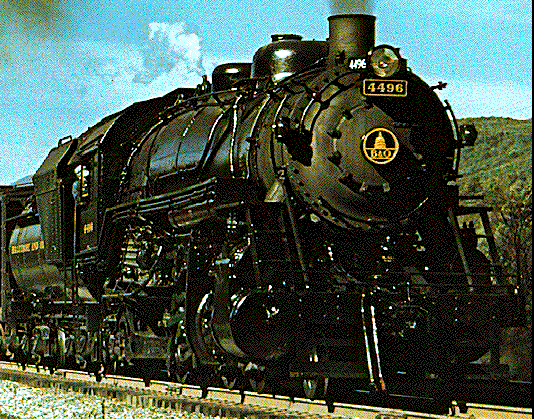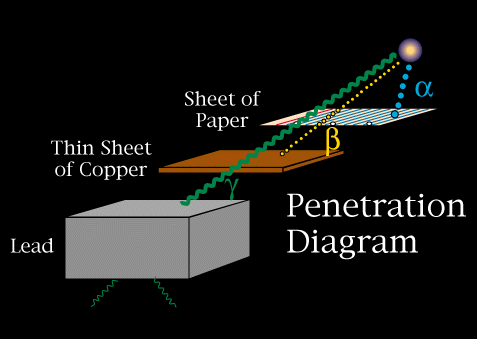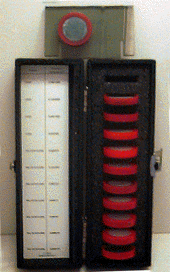

EXPERIMENT #4:
PENETRATING POWER
Introduction
There is a great difference in the penetrating powers for alpha, beta, and gamma rays. Of the three types of radiation, alpha particles are the easiest to stop. A sheet of paper is all that is needed for the absorption of alpha rays. However, it may take a material with a greater thickness and density to stop beta particles. Gamma rays have the most penetrating powers of all three radiation sources.

Objective
The purpose of this experiment is to demonstrate the interactions of alpha, beta, and gamma radiation with matter.
Absorber/Shielding Set
 |
Materials
- radiation sources:
- Po-210 (alpha source)
- Sr-90 (beta source)
- Co-60 (gamma source)
- Geiger counter
- rail tracker
- absorber set
Procedure
Part A
- Place alpha radiation source into hole on wooden block of rail tracker.
- Set digital Geiger counter to x1 scale and turn power on. Allow the instrument to warm up for a few minutes.
- Record background activity.
- Arrange the polyethylene samples according to thickness with the least thick first. Place the polyethylene in the special material holder on the rail track. Move the Geiger counter and slider next to the sample.
- Take three trial readings of radiation intensity for each thickness of polyethylene and record in Table 4.1. The time required for each trial is 10 seconds. Because of fluctuations with the meter, better results are obtained when counting beats.
- Plot a graph for this activity: thickness vs. number of counts.
Part B
- Replace the alpha source with the Sr-90 (beta source).
- Check Geiger counter for x1 setting.
- Arrange the plastic and lead samples according to thickness with the least thick first. Place the first sample in the material holder. Move the Geiger counter slider next to the sample.
- Take three trial readings of radiation intensity for each thickness of all samples and record in Table 4.2. The time for counting number of beats is 10 seconds. Again, count the audible beats.
- Plot a graph for this activity.
Part C
- Replace the beta source with Co-60 (gamma source).
- Check x1 scale position on the Geiger counter.
- Arrange the lead samples according to thickness with the least thick first. Place the first lead sample in the material holder. Move the Geiger counter and slider next to the sample.
- Take three trial readings of radiation intensity for each thickness of all lead samples and record in Table 4.3. The time for counting number of beats is again 10 seconds. Remember to count the audible beats.
- Plot a graph for this activity.
Data
Table 4.1:ALPHA RAYS-POLYETHYLENE
Background __________ cpm po-210
| Thickness (inches) |
Scale |
Trial 1 |
Trial 2 |
Trial 3 |
Average |
| 0.0040 |
|
|
|
|
|
| 0.0080 |
|
|
|
|
|
| 0.020 |
|
|
|
|
|
| 0.030 |
|
|
|
|
|
| 0.062 |
|
|
|
|
|
| 0.125 |
|
|
|
|
|
| 0.250 |
|
|
|
|
|
Table 4.2: BETA-POLY AND LEAD
Background __________ cpm Sr-90
| Thickness (inches) |
Scale |
Trial 1 |
Trial 2 |
Trial 3 |
Average |
|
|
|
|
|
|
Polyethylene |
|
|
|
|
|
| 0.0040 |
|
|
|
|
|
|
|
|
|
|
| 0.0080 |
|
|
|
|
|
|
|
|
|
|
| 0.020 |
|
|
|
|
|
|
|
|
|
|
| 0.030 |
|
|
|
|
|
|
|
|
|
|
| 0.062 |
|
|
|
|
|
|
|
|
|
|
| 0.125 |
|
|
|
|
|
|
|
|
|
|
| 0.250 |
|
|
|
|
|
|
|
|
|
|
|
Lead |
|
|
|
|
|
| 0.032 |
|
|
|
|
|
|
|
|
|
|
| 0.062 |
|
|
|
|
|
|
|
|
|
|
| 0.125 |
|
|
|
|
|
|
|
|
|
|
| 0.250 |
|
|
|
|
|
|
|
|
|
|
Table 4.3: GAMMA RAYS-LEAD
Background __________ cpm Co-60
| Thickness (inches) |
Scale |
Trial 1 |
Trial 2 |
Trial 3 |
Average |
| 0.032 |
|
|
|
|
|
| 0.062 |
|
|
|
|
|
| 0.125 |
|
|
|
|
|
| 0.250 |
|
|
|
|
|
Questions
- Why allow time for the Geiger counter to warm up?
- Is it necessary to take background readings every day? EXPLAIN.
- What type of results would you expect if the same alpha sample was doubled in quantity?
- Is polyethylene an effective shield for beta radiation? Is lead? Explain.
- What results would you observe if you used aluminum for shielding beta rays?
- From your graph, what thickness of lead is needed to absorb Sr-90 beta rays? For Co-60 gamma rays?
- What materials, other than lead, are effective for shielding gamma radiation?
- What amount of lead is needed to reduce gamma radiation to one-half of a previous intensity count?
- What general statements can you make about the thickness of the absorbing material on the count rates?
Going Further
- If the density of air is 1.3 mg/cc, then how long a column of air would be needed to absorb beta rays in the source Sr-90?
- How long would a column of air need to be to reduce the intensity of Co-60 gamma rays by a factor of 10? Explain.
- Make a chart comparing alpha, beta, and gamma radiation, including such information on charge, mass, penetration, speed, and energy.
This document was produced by the Nuclear Science Division of the Lawrence Berkeley National Laboratory.



